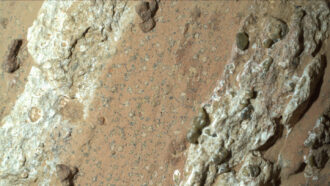
Planets
Pluto and its moon Charon may have paired up with a kiss
After about 30 hours of contact, Charon could have separated from Pluto and drifted into its current orbit.
Come explore with us!

After about 30 hours of contact, Charon could have separated from Pluto and drifted into its current orbit.

This sandlike dust blankets planets, asteroids and other rocky surfaces of our solar system, including our own planet.

Voyager 1 and 2 left Earth in 1977 to fly by the outer planets. Nearly 50 years later, these spacecraft are still transforming our knowledge of space.

Images of six Jupiter-sized worlds taken by the James Webb Space Telescope offer clues to how planets and stars form.

Ongoing observations and new lunar rock samples, including the first from its far side, should point to how both the moon and our Earth evolved.

Clues about this ancient protoplanet's catastrophic end may have been entombed in Earth's lower mantle for billions of years.

Let’s make our own craters in cocoa and flour to learn how these features form throughout the solar system — and why they’re different sizes.

If the windstorm keeps dwindling, the Great Red Spot could someday disappear — like an earlier spot observed in the 1600s.

This magnetic field encapsulates our planet, sheltering us from damaging energetic threats posed by the cosmos and our own sun.

The robot examined a Mars rock containing organic compounds and “leopard spots.” On Earth, such spots usually come from microbial life.